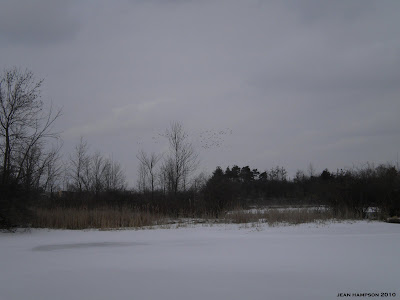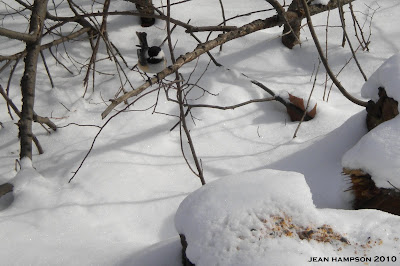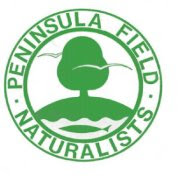Saturday, February 27, 2010
GBBC 2010
February 12: Lakeside Park
Jean and I had to work Friday but we did a quick count at the marina in Port Dalhousie, late in the afternoon. The last visit, we were searching for Mute Swan to add to the regional list. Of course this time, with the list completed, 3 Mute Swans decided to make an appearance.
February 13: Birding along the Twelve
Twelve Mile Creek runs through Short Hills Provincial Park and widens considerably at the Decew Falls generating station. The swift current flows south and empties into Martindale Pond. The name does not derive from the creek's length but because its outlet is 12 miles from the Niagara River. Many creeks in the region are so named (4 Mile, 15, 16, 20 and so on). Yes, the British were quite imaginative in naming the creeks in Upper Canada.
On the Saturday, Jean and I birded along the trails of Twelve Mile Creek, the Merritt Trail and the Twelve Trail.
The Merritt Trail follows the former routes and the present route of the Welland Canal and we birded the section on the west side of the creek. I like this area for finding one species of bird in particular, the Red-headed Woodpecker. All of our Niagara observations of this species have been on this stretch of the Merritt Trail. There are many dead and dying trees on the flood plain that provide a favourable environment for the species and I like to go before the view of the trees in the valley below the trail are blocked by the emerging leaves in the spring.
Though we have seen Melanerpes erythrocephalus several times while hiking on the trail, the woodpecker would remain off our checklist for the GBBC. The feeders in the yards of the townhouses that back onto the trail were very active. House Finches, Black-capped Chickadees, American Tree Sparrow, and American Goldfinches (a total of 20) were observed visiting the feeders.
We travelled up stream to walk on the Twelve Trail, along the east side of the creek (north of Glendale Avenue). Other than for GBBCs, we rarely hike this trail. Jean and I should make an attempt to explore the trail in warmer weather. Due to the fast current the water remains open, so there may be interesting waterfowl found here during the winter months.
This year we found small numbers of Bufflehead, Common Goldeneye, Hooded Merganser, Mallard and American Black Duck. A Belted Kingfisher was very vocal as it flew from branch to branch along the banks of the creek. Though they are quite numerous in southern Ontario in the summer, Double-crested Cormorants are a rare sight at this time of year. As we did on our first GBBC, we were able to tick cormorants (3) for our checklist. Returning to the parking area, we spotted a pair of Carolina Wrens in the brush along the side of the trail.
The best find of the day was not along the creek but below Brock University, across from a residential neighbourhood. Last year, Jean and I had the great fortune of viewing a Great Horned Owl nesting pair. It was mid-April and the two young in the nest were quite large, leaving little room in the nest for anything else. The young were just as interested in the birders below as we were of them.
Well, it looks like the Great Horned Owls have returned. One owl was on the nest. We checked the surrounding trees for its mate but we did not find it. We'll return to the nest every so often to monitor the progress of the owls. Hopefully they have the same reproductive success as last year.
February 14: Niagara River
What better way to celebrate Valentines Day than with a wife whom enjoys birding as much as I do. Jean and I would search the Niagara River for interesting waterfowl, travelling along the Niagara Parkway from Fort Erie to Chippawa.
In Fort Erie, south of the Peace Bridge, Red-breasted Merganser, Bufflehead, Common Goldeneye, Lesser Scaup and American Black Duck were seen where Lake Erie ends and the Niagara River begins. I determined the large floats of ducks were in U.S. waters and it was best to leave the counting to the birders in Buffalo.
South of the International Railway Bridge, we spotted over a dozen Great Black-backed Gulls and 70+ Common Mergansers.
Further along the river, we found our first cluster of Tundra Swans (24) of the day. Common Goldeneye and Common Merganser were the highly counted species. Canvasback were observed for the first time and would be seen at many spots in great numbers along the Niagara until we reached the village of Chippawa.
With river birding completed, Jean and I turned our attention to the feeders we have visited a number of times. The usual entertaining species were found, including Tufted Titmouse (2) and our first Red-breasted Nuthatch for 2010.
February 15: Lake Ontario
Monday was the provincial holiday Family Day and since 2008, Ontarians honour the third Monday in February as a statutory holiday.
This year it coincided with the GBBC, allowing Jean and I to contribute additional checklists for count. Three species of scoter were observed on Lake Ontario recently and one species (Black Scoter) is still needed for our life list. From the beach, just outside of Fifty Point Conservation Area, we scrutinized the first scoter we found. I was hoping it would be a lifer but the white secondaries, not apparent at first, were observed on this female White-winged Scoter. We scanned the birds further out on the lake but all we could find amongst the Common Goldeneye and Long-tailed Ducks were more White-winged Scoters. Other waterfowl observed included, Lesser Scaup, Canada Goose (350) and Mute Swan. Two raptors were also counted, a Red-tailed Hawk and a Cooper's Hawk.
With no Surf or Black Scoters counted, we left for the last spot of our 2010 GBBC. We went to the outlet of Forty Mile Creek. Yes, we were 40 miles from the Niagara River. On Boxing Day of last year, we observed the Barnacle Goose of unknown origin. For now, it remains on the list with an asterisk and will be removed if the OBRC conclude that its origins are unknown. Waterfowl and gulls were counted but there were no new additions for the count.
Over the weekend, we observed 42 species and submitted 12 checklists for the GBBC. Looking at the results on the GBBC site, a total of 132 species were reported in Ontario. Great to see so many birders participating in the count!
With our contribution completed for another year it's time to concentrate on the winter list. After the GBBC, the winter list stands at 73 species (two more than the 2008/2009 list) and there were more to come the following weekend while birding Lake Gibson and Short Hills Provincial Park. You'll have to wait for the next post to find out how we did.
Sunday, February 21, 2010
A Long Line of Cars in Haldimand-Norfolk
After a brief description of our itinerary, 46 birders in 26 vehicles headed for Ruthven Park.


The wood duck boxes along the creek could possibly contain screech owls so Dave played a tape of the owl's call as we all fixed our bins on the wood duck box. No owls but there was quite a bit of activity at the rear of the property. Amongst the many American Tree Sparrows, Black-capped Chickadee and Dark-eyed Juncos we spotted 1 Chipping Sparrow. The White-throated Sparrow seen by some of the group was not ticked by Jean and I. Two additional species of woodpecker (Hairy and Red-bellied) were also observed.
Near Selkirk, we travelled along the Blue Water Parkway to view waterfowl on Lake Erie. It was very cold here and we found only 3 species of duck. We quickly checked out some feeders and ticked a Red-winged Blackbird and a Song Sparrow. I missed out on the Red-breasted Nuthatch. Hard to be in two places at once with such a large group.
We stopped for lunch at the Sunflower Cafe in Selkirk and the staff did very well feeding the 40+ birders that invaded their restaurant without any warning. After a fulfilling bowl of chicken oriental soup I was ready for some more birding. We headed to the Nanticoke coal burning generating station and while travelling along the lake's shoreline towards Nanticoke, the group stopped to scan a large flock of Canada Geese for other waterfowl. While checking out some feeders across the road, a few in the group were "mooned" by a resident from his living room window.
Arriving at the east side of the generating station, we were greeted by the sun and 3 soaring immature Bald Eagles.

Standing on a bluff overlooking Lake Erie, we shared views through our scope with Anne and Bev, our carpooling friends from the Long Point trip last year. Anne will be travelling to Panama in the near future and she once proclaimed she had scope envy. Well I can rightfully say I have "travelling to a destination outside of the ABA area envy"! Jean and I added Gadwall to the year list at Nanticoke. With Bev done birding for the day, Anne joined Jean and I for the remainder of the trip. An extra pair of eyes is always welcomed. North of the generating station, the long line of cars stopped to get a view of a distant Rough-legged Hawk. Another tick for the year list.
Not much observed on the west side of the generating station so we continued on to Port Dover to view waterfowl in the harbour and along the shoreline. This was our last observation with the OFO group.




Rather than take a natural break and pick up some coffee at Tim Hortons, Jean, Anne and I decided to head for the next stop on the trip, the Fisherville Raptor Centre. Though we followed the directions correctly, we could not find the centre. We contacted Dave by cell phone and found we travelled too far east. At home I discovered we had past the raptor centre without seeing it. It gets better. Not only did we pass the centre, we may have even stopped near it while taking a close look at a dark morph Rough-legged Hawk. For those of you that use eBird, you will know that "hot spots" appear as red dots on your map when plotting an observation. Well, when I plotted the Rough-legged Hawk observation, the red dot for the Fisherville Raptor Centre was on the same section of road. In fact, it may have been on the opposite side of the road from the hawk. This hawk had distracted us! That's my story and I'm sticking to it.
We attempted another call to Dave's cell but with no answer, we decided to call it a day at 4:00 PM. The trip report I received later in the evening informed that the trip continued on to 5:30 PM and 4 Short-eared Owls were observed at the Hagersville dump.
Though we did not see any owls, Jean and I had a good day of birding. We added 5 species to the year list and ticked a total of 30 species. The group observed a total of 50 species and did very well avoiding an accident with all the avian distractions we encountered. The driver we came across back in St. Catharines however, was totally distracted. Although the vehicle was stopped at a red light, they were driving the wrong way, on a one way street while using their cell phone!
The next weekend was busy. The 2010 Vancouver Olympics was on multiple channels, Valentine's Day on the Sunday, followed by Family Day but most importantly it was time for another The Great Backyard Birdcount. Birds of Niagara, prepare to be counted.
Thursday, February 11, 2010
Darwinian Cinema
Tuesday, February 9, 2010
Plus One
It was the last day of January and I set some time aside for a final attempt to add birds to the January list. The previous day Jean and I ticked 11 species, setting a new total for the list. Rather than rest on my laurels, I thought it would be worthwhile to add a couple more species. This would make next year's list all the more challenging.
There was another open body of water that could possibly produce the swans. Up to my home town of Thorold we would go. The waters of Lake Gibson are channeled to the Decew Hydro Generating station and a few spots remain open during the winter months.



With birding officially done for the month of January, Jean and I observed a total of 57 species within the region of Niagara. A new personal best. Having missed a Bonaparte's and Little Gull, I know it is feasible to obtain 60+ species next year. I already have my itinerary mapped out in my head. In addition to continuing the tradition of a January regional list I will also take on the Bird-A-Day challenge. Yes, the lists are ever growing.
I'll be prepared next year. Who knows, may be I'll even keep pace with a certain Carolinian birder that has yet to miss a day.
Sunday, February 7, 2010
Last Chance Weekend





At the feeders near the pond we observed another surprise feeding with the juncos, cardinals and tree sparrows. A female Red-winged Blackbird!
Above the Falls we had the same result as the Whirpool. A large amount of ice (it was January after all) and hardly any gulls. A few Herring Gulls in flight and a lone Great Black-backed Gull sitting on the ice.










